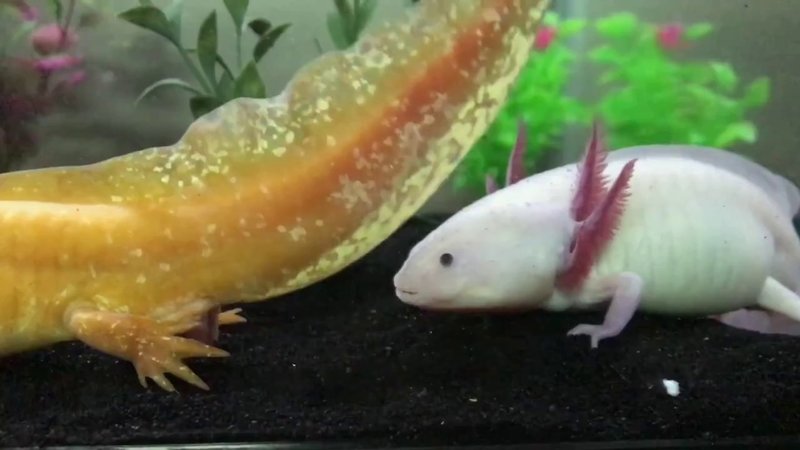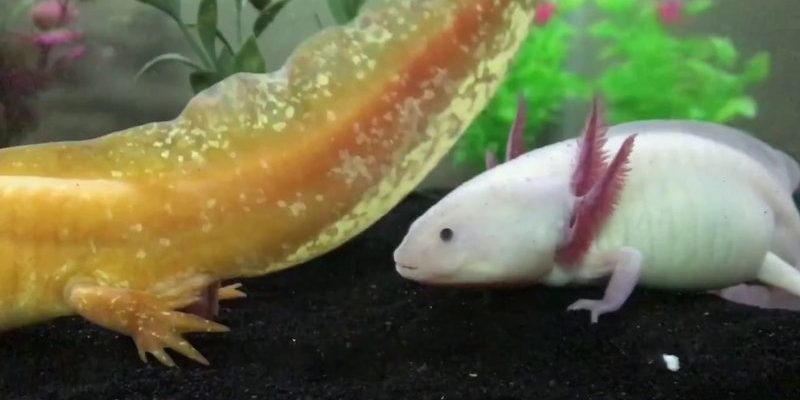
Axolotls, also known as “Mexican walking fish,” aren’t fish at all but amphibians. They spend their entire lives in water, which means their breeding behavior is closely tied to their aquatic habitat. These fascinating creatures have a unique way of attracting mates and laying eggs, and it’s all part of their natural life cycle. So, if you’ve ever been curious about how these charming critters go about finding love and carrying on their species, you’re in for a treat.
Understanding Axolotl Mating Rituals
Axolotls have some interesting courtship behaviors that can be quite entertaining to observe. The process usually starts with the male axolotl performing a unique dance to attract the female. He’ll wiggle and swim around her, using his gills and body movements to show off his health and vigor. You might think of it as the creature’s version of trying to impress a date with some smooth moves!
During this dance, the male will also release pheromones into the water. These chemicals serve like a love potion, signaling to the female that he’s ready to mate. If she’s interested, she’ll respond by following him closely. It’s almost like a romantic chase, where the female decides if he’s worthy of her attention. This is nature’s way of ensuring the strongest and healthiest individuals get together.
Once she’s ready, the male will lead her to a suitable spot to lay eggs. This behavior is a crucial part of their reproductive success, as finding the right place can greatly affect the survival of their offspring. So, the mating dance is not just about wooing; it’s also about strategy.
Egg Laying: The Axolotl’s Next Chapter
After a successful courtship, it’s time for the female to lay her eggs. Axolotls are quite prolific; a single female can lay anywhere from 300 to 1,000 eggs at one time! The female typically lays her eggs in clusters, attaching them to aquatic plants or other surfaces underwater. You can think of this as her way of creating a nursery for her future babies.
The eggs are small and transparent, making it easy to see the developing embryos inside. The whole process can be quite stunning to watch. If you’re into aquatic life, it’s like nature’s own reality show where you get to see the beginning of life unfold right before your eyes.
Once the eggs are laid, they’ll take about two weeks to hatch, depending on water temperature and other environmental factors. During this time, the eggs need to be kept clean and free from fungus, which can be harmful. This is where the parental instinct kicks in—though axolotls don’t typically care for their offspring after laying eggs, ensuring a good environment is essential.
Hatching: The Miracle of Birth
When the eggs hatch, tiny axolotl larvae emerge, ready to enter the world. These little guys are fascinating to behold. They usually start out very small, measuring just a few millimeters in length, and they come equipped with little gills. These gills, resembling feathery fans, are how they breathe underwater, and they’ll continue to grow as they mature.
It’s interesting to note that the newly hatched larvae are pretty self-sufficient right from the start. They begin feeding on tiny organisms like infusoria and will gradually transition to larger foods as they grow. In many ways, it’s a race for survival—those that can find food quickly are more likely to thrive and eventually reach adulthood.
However, not all larvae will survive. Predation is a real threat in the wild. Even among siblings, larger axolotls may eat the smaller ones, which is a natural part of the survival process. This harsh reality showcases how important it is for these creatures to grow quickly and adapt to their environment.
Sexual Maturity: The Journey to Adult Life
Axolotls typically reach sexual maturity between 6 to 12 months of age. That’s pretty quick for such a unique creature! Once they reach maturity, they can begin this incredible reproductive cycle all over again. This phase is where their vibrant personalities really shine. They can become quite social, especially when there are mating opportunities available.
Interestingly, axolotls have a unique reproductive strategy. Unlike many other amphibians that undergo drastic changes during their lifecycle, axolotls can remain in their larval form indefinitely, a process known as neoteny. They can reproduce while still keeping their juvenile characteristics, which is one of the many things that makes them special.
Given their ability to regenerate lost limbs and even parts of their heart or brain, it’s no surprise that scientists are keenly interested in studying their reproductive behaviors. Understanding how they reproduce and grow gives insights into their overall biology and potential applications in medicine.
Environmental Factors Affecting Reproduction
The reproductive success of axolotls can be significantly influenced by environmental factors. Temperature, water quality, and habitat play crucial roles in their breeding behavior. Ideally, they thrive in cool, clean water, with temperatures ranging from 60°F to 68°F (15°C to 20°C). If the water gets too warm, it can stress them out, reducing their desire to breed.
Additionally, the presence of suitable hiding spots and plenty of vegetation is vital. These factors create a more comfortable environment for both mating and egg-laying. You might think of it like setting up a cozy home for a family—if it feels safe and secure, the likelihood of successful reproduction increases.
Water quality is also critical. High ammonia or nitrate levels can be harmful, affecting reproductive health. Regular monitoring and changing of water in a home aquarium can greatly contribute to a successful breeding environment for these remarkable creatures.
Challenges in Axolotl Breeding
Breeding axolotls is not without its challenges. While they can be prolific, ensuring that fertilization occurs is key. Sometimes, despite all the courtship antics, a female may not lay eggs or the eggs may not be fertilized. This can be due to several reasons, like stress or incompatible mates.
Another challenge is ensuring that the offspring have a good chance of survival. With high competition for food and space in the wild, many young axolotls won’t make it to adulthood. In a home breeding setup, being mindful of tank size and food availability can make a significant difference in the survival rates of the larvae.
Lastly, potential diseases can pose a significant threat to axolotls, especially in a breeding situation. Keeping their environment clean and monitoring for signs of illness helps maintain a healthy breeding process.
The breeding and reproductive behavior of the axolotl is a captivating journey that showcases the resilience and adaptability of this incredible species. Their unique mating rituals, the delicate egg-laying process, and the fight for survival among the larvae all illustrate the complexity of their lives. As we learn more about these creatures, we can better understand their needs and how to help conserve their populations in the wild.
You might find that the axolotl’s story is not just about reproduction but also a testament to nature’s wonders and challenges. Whether you’re thinking about keeping axolotls as pets or simply fascinated by their biology, understanding their breeding behavior adds depth to your appreciation of these extraordinary amphibians. There’s always something new to learn and discover about the axolotl, reminding us just how intertwined our worlds are with the creatures around us.

